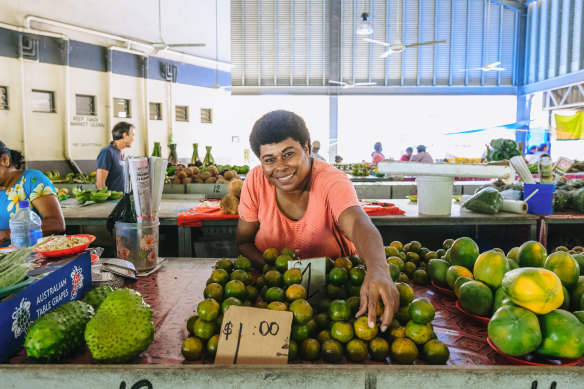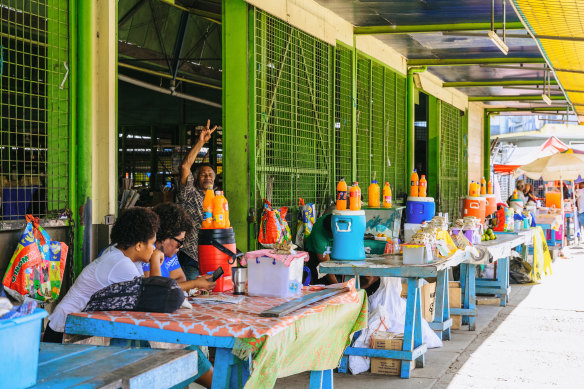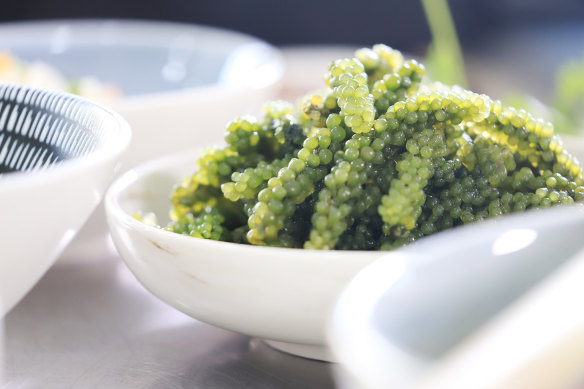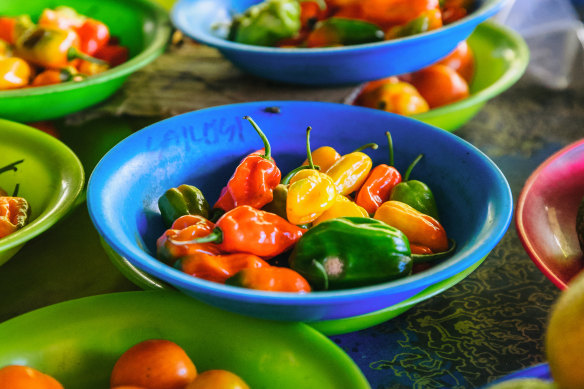The tiny superfood that’s Nadi’s best-kept secret
Saturday is market day in Nadi, and it feels like everyone is in town. Women in brightly patterned sulu chambas walk between tables greeting friends, children hover beneath stalls gathered around a smartphone, men compare their catch in the fish market and weathered trestle tables are piled high with fresh produce: mud crabs standing at attention with their claws tucked together, hessian sacks of black pipis leaning against pillars, and there are neatly stacked piles of taro, cassava, papaya and pineapple laid on cardboard pieces on the floor.

The real deal: Nadi Municipal Market.Credit:
Nadi’s compact size is often a surprise for visitors, who expect a much larger city. Along with the Municipal Market, there’s a main street with retail shops, the colourful Sri Siva Subramaniya Swami Temple and a dedicated handicrafts market for tourists. Most daytrippers to the town head to the handicraft market across the street, but the Municipal Market is Nadi’s best-kept secret.
This is not a market filled with tat or discount carpet cleaner, nor is it one overrun with influencers and Instagrammers: it’s a place that exists for the locals, save for one or two expats, and is filled with produce grown locally, specific to the region and reflective of the land, its ocean and its people.

The market offers a rare glimpse into what life is really like on the island.
There are two specific items you can find here that you’ll struggle to find elsewhere in the world. The first is, of course, kava. There’s an entire covered pavilion dedicated to the prized root crop, renowned for giving those who imbibe a relaxed buzz. There are piles of the grey root sliced neatly into rounds, big bushels wrapped with colourful ribbon for gifts, and brown paper bags filled with ground powder manufactured for tourists. Just like fine wine, terroir matters: the kava on Savu Savu, for example, is more prized than elsewhere, and as a general rule, the older the plant, the better the quality.
However, kava isn’t my cup of tea, especially this early in the morning. What I’m searching for is rarer and harder to find. I’m looking for nama, the small sea grapes collected from the shallows around the outer islands. Translucent green, with fruit smaller than pine nuts and attached to tiny branches, the edible seaweed has made a big splash lately as a Fijian superfood, largely due to its high concentration of minerals and vitamins. Also known as sea caviar, nama has become a popular ingredient in the wellness and beauty sector, with the Fijian-owned NAMA skincare line becoming the product of choice in many of Fiji’s top luxury hotels. Its increasing popularity has made it scarce, and I’m not sure that I’ll find any in the market today.

The Fijian delicacy known as “nama”, or sea grapes.Credit:
We walk up and down the stalls searching for it: past the buckets of spices and lentils piled high on the back walls, along the outskirts where pumpkins rest on blue tarps on the ground, past the corn being roasted on hot coals and into the next pavilion, where tennis-ball sized eggplants are stacked on plastic plates and chillies are laid out on newspaper. My husband doubles back for some kava, the eldest gets fresh juice squeezed from tiny local oranges bobbing in ice, while the youngest ends up coated in bright red mangosteen powder from the pineapple popsicle he snacks on.
With no sign of the nama, I pick up a sweet-smelling pineapple and bright yellow papaya to take back to the resort to snack on later. I almost give up, but on the way out, I spy a parcel of the tiny sea grapes, stacked elegantly on bright plastic plates. It’s like finding a small treasure. Firm yet delicate, briny and fresh, I relish each tiny, briny morsel on our way back to Denarau.

Nadi’s market is full of fresh fruit and vegetables.Credit:
As a general rule, markets tend to divide travellers: some love them, others hate them. For my wide-eyed kids, who spend most of their time in Fiji at the kids club on Denarau Island, it’s a chance to see that seafood, fruit and vegetables don’t magically appear blemish-free in cellophane at the supermarket. And in a place like Fiji, where it’s increasingly hard to break out of the resort and all-inclusive tour bubble, Nadi’s Municipal Market offers a rare glimpse of what local life is really like.
The details
Visit
Nadi Municipal Market is by the bus station on Market Road in Nadi Town on the island of Viti Levu. Open 7am-5pm, closed Sundays.
Fly
Fiji Airways operates several flights from the East Coast to Nadi daily. See www.fijiairways.com
Stay
Denarau Island has eight resort-style hotels open to guests: The Palms and The Terraces by the port are great self-contained options. See denarau.com
More info
www.fiji.travel
The writer travelled with the assistance of Tourism Fiji.
Sign up for the Traveller Deals newsletter
Get exclusive travel deals delivered straight to your inbox. Sign up now.